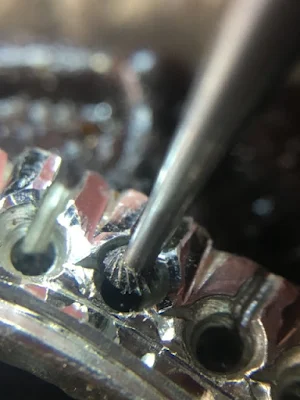"Fish-Tail" gemstone setting is one of the most intricate designs that can be created without any CAD (computer aided design) program.
I'd rate this exercise at about "18+ out of 10". The only tools that I use are a Flat graver of #40 width that is used for Bright-Cutting (for a much required wider cut).
(This essay was originally dated Nov. 2023, I feel that it's necessary to review this again, but with many greater photo details.)
WHY IS THIS NAMED "FISH-TAIL"? The two beads are the fish's eyes and the two curves are it's tail-fins.
=============================================
One of the many designs I use extensively is using solely a Flat graver #40 in width. To initiate the cutting, I start with the corner of the blade as being shown here.
I didn't (on purpose) burnish the 'beads'. I was more interested in getting the stones set that I had more things to do. For example Bright-Cutting the metal.....everywhere!
My emphasis during this stage of metal-carving is to make sure that the beads are now 'rounded'.
How do I keep the stones in the 'fish-tail' design? This is so very easy, let's start to explain this interesting technique.
I will carefully grab the Fish's curved areas and pull the curved areas together with a pair of fine-toothed jaws. If you wish to use your 'hand-pusher' that is another option.
On either side of the 'fish's tail' are these two seats. I will use my 156C (Carbide) bur and create two seats inside of the hole, this where the gemstone will sit, but not securely!!!
You can easily see the '156C' under-cutting bur making a seat inside the hole. This 'bearing-carving' must be formed all around the hole, as this is where the stone will sit.
In this up-close photo shows the bur in action.
Long before any gemstone is set, much care is taken in cleaning all of the areas that is to shine from the "Bright-Cutting" processes.
This great photo is showing you some of the bearings where the stone will sit. With your bud-shaped bur cut at an angle in between the two beads.
THERE MUST NOT BE ANY EXTRA METAL remaining in between the two beads. Get it removed NOW!
Don't be too cautious in using your 156C bur. Utilize the edges of the 'rotating bur' to navigate around the hole. From here you will have a nice seat for every stone.
"Bright-Cutting" is the most challenging aspect of this pattern. You are not removing or destroying any areas of the design, but enhancing the pattern many times better.
The enhancing makes every metal angle 'bright and shiny'.
This sliver of metal is from the Flat graver doing what it's supposed to do. It's to give lustre to the 'rough-cutting', there must not be any lines in the face of the graver.
If the graver face is poorly polished (on your polishing paper & oilstone) then those 'graver defects' will leave poorly created lines in the fish-tail pattern.
KEEP YOUR TOOLS CLEAN AT ALL TIMES.
This photo displays the bright cutting edges that we are all aiming for, agree?
To review again, use your #004 bud-shaped bur and keep the metal clean of any extra metal in between those two beads. All that you should have are two little 'posts'. These two posts are your new beads.
Your Flat graver is again 'doing it's magic' on the metal. Keep your tools sharp!!!
'Bud-Shaped' bur can do so much in this subtle metal carving.
The Bright-Cutting results shown in this photo, are only 'mediocre' but not very clean.
In this better photo, you can see how important a pristine looking Flat graver can be.
With a Flat graver, every section of the front of the blade is doing wonderful things to the metal. By starting at the edge and slowly working with the center of the blade, every millimeter of the Flat graver is being used.
This is my epitome of a good polishing paper, I use any polishing paper from #800 grit all the way up to a #1,200 grit, why? I WANT PERFECTION, nothing else!
I will place this setting process at "18 out of 10". But once that these techniques have been learned, then come the practising, this practising "Fish-Tail" took me 2 YEARS.

.JPG)
.jpg)
.jpg)







.JPG)

.jpg)
.JPG)
.JPG)
.jpg)
.jpg)
.JPG)
.JPG)
.jpg)




.JPG)



.jpg)








.JPG)





.JPG)



.jpg)

.jpg)
.jpg)
.jpg)
.jpg)
.jpg)
.jpg)
.jpg)
.jpg)
.jpg)
.jpg)
.jpg)
.jpg)
.jpg)
.jpg)
.jpg)
.jpg)